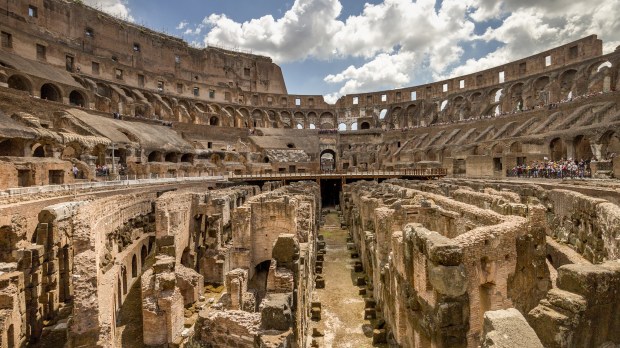To wander Rome, the Eternal City, is to encounter layers and layers of human history, some piled quite literally on top of itself. Beneath the great baldacchino of Bernini in Saint Peter’s Basilica are foundations laid by Constantine in the fourth century, and beneath those foundations is a Roman necropolis where the body of Saint Peter was unceremoniously dumped nearly two thousand years ago, before his disciples came and made it a place of devotion. As one walks around the city, one sees sixteenth century churches across the square from thirteenth century ones. One can see the monastery built by Catherine of Siena atop an ancient Roman market, across the street from a massive twentieth century monument to Vittorio Emmanuele, across the street from an ancient Roman prison that may have incarcerated Saint Peter.
These layers are fundamentally stories of people moving about their daily lives, experiencing the most basic truths of our condition: hunger and thirst, love and sin, courage and fear, the desire for beauty and goodness and truth. What is particularly striking about Rome is the fact that these experiences are given expression in so many grand artistic forms: in fresco, architecture, story, sculpture, and music. As grand as they can be, though, there are constant reminders that these too might pass away. The Roman forum was a massive, eye-popping, beautiful complex without rival in the ancient world; and yet today it is reduced to rubble, with many of its stones hijacked at various times to be used elsewhere. Perhaps one day too the largest church in the world, with priceless works of art in every corner, will pass away, to be replaced by the next layer of history.
That prospect need not trouble Catholics, whose churches and works of art have undergone many changes over the centuries. A church in ruins need not be the sign of the Catholic Church in ruin. One night, very late, I strolled near the ancient Roman Forum and found myself stopping for a moment at the once-grand Arch of Septimus Severus. Alone in the darkness, I imagined emperors and generals processing through that arch, to the adulation of gathered crowds. Percy Bysshe Shelley expressed something of the futility of such grand memorials in his poem “Ozymandias,” reflecting on a monument now lying in ruins in the sand:
And on the pedestal these words appear: ‘My name is Ozymandias, king of kings: Look on my works, ye Mighty, and despair!’ Nothing beside remains. Round the decay Of that colossal wreck, boundless and bare The lone and level sands stretch far away.”
Like the monument to Ozymandias, the arch now stands silent, a slow victim of millennia of weather. The generals and emperors are long dead, as are the martyrs they slaughtered for sport. Yet those martyrs, to paraphrase Tertullian, gave rise to a Church very much alive. Some of its buildings are no more, but the faith expressed in their walls is still world-changing.
Christians have a very long historical memory which shapes their imagination of the world in which they live. A stroll through Rome is not only a walk through history; it is a living lesson in what changes, and what remains. And what remains in the Christian imagination is a God who transcends any moment in history, any time-bound expression of faith. Empires rise, empires fall. Columns rise; columns fall. Mosaics and frescoes amaze; and yet they fade or are destroyed. What will remain of modern empires? And what will remain of our contemporary expressions of faith? Will our descendants find our art forms worth preserving or rescuing from ruin? Will our modern churches be excavated for hints of what gave meaning to our daily lives? Ancient Greek philosophy arose out of a fundamental question that still challenges us today: what is constant, and what passes away?
Saint Teresa of Ávila’s prayer echoes in my mind like a serene chant as I walk through the layers of Roman—and Christian—history.
Let nothing disturb you, Let nothing frighten you, All things are passing away: God never changes. Patience obtains all things Whoever has God lacks nothing; God alone suffices.
Frankly, I am rather positive that much of our modern forms of prayer and worship will pass away, into the dustbin of history. That is not necessarily a bad thing; silly conversations we have with loved ones are not memorable but for the fact that they are expressions of our love for them. So too with our worship: we have silly conversations with God that God loves, even as he draws us deeper into the stillness of encounter with him, into the place where, in the words of Saint Francis de Sales, “heart speaks to heart.” Yes, both pagan and Christian basilicas will rise and fall like the sunrise and sunset on various epochs of human history. All things are passing away, but God never changes. My deepest desire is, to use the psalmist’s words, to live in the house of the Lord forever.
Tim Muldoon (Ph.D. Catholic Systematic Theology, Duquesne University) is a theologian, professor and award-winning author who serves in the Division of University Mission and Ministry at Boston College, where he edits the journal Integritas: Advancing the Mission of Catholic Higher Education, a publication of the Boston College Roundtable.

